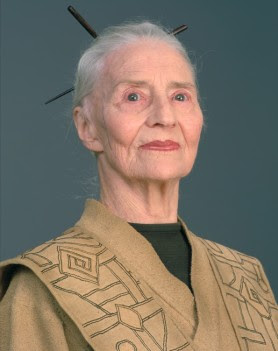 |
| Statue of Genghis Khan in front of the Government Building in Sükhbaatar Square, Ulaanbaatar, Mongolia. Image courtesy of GenuineMongol/Wikipedia. |
In December of 1241, Mongol armies stood poised to invade Vienna and northern Albania. Thus far they had been unstoppable as they spread into Europe. Led by Batu Khan, grandson of Genghis by his son Jochi, at the last minute he was informed of the death of the current great Khan, Ogedei. According to Mongolian military tradition, when a Khan died all the princes immediately met to elect a successor. Europe was saved from what would have been an inevitable takeover.
 |
| Coin of Genghis Khan minted at Balkh, Afghanistan in 1221 CE. Image courtesy of PHGCOM/Wikipedia. |
The Khan lineage did manage a huge takeover in another realm - genetically. For centuries most Asian potentates have claimed descent, many spurious, from the House of Borjigin - the most famous family in Central Asia. Members of the clan are still found throughout Mongolia, Xinjiang, and Kazakhstan. According to legend, one of the female ancestors was impregnated by a ray of light, and the spawn of that light sired the entire Mongol nation.
 |
| Portrait of Genghis Khan. Image courtesy of Cultural China. |
However, with the advent of genealogical DNA testing, which examines the nucleotides at specific locations on a DNA strand, it is possible to really trace the ancestry of the Great Mongol ruler Genghis Khan. A man's patrilineal ancestry can be traced using the DNA on his Y chromosome. The Y chromosome passes down virtually unchanged from father to son, unlike other parts of the genome which recombine. A man's test results are compared to another man's to determine when they shared a "most recent common ancestor" or MRCA. (Matrilineal ancestry can be using mitochondrial DNA, or mtDNA.)
 |
| Portrait of Genghis Khan from the 14th century. Paint and ink on silk. Image courtesy of Wikipedia. |
In 2003, an international group of scientists identified a Y-chromosomal lineage present in about 8% of the men in a large region of Asia (amounting to about 0.5% of all men in the world), or about 16 million descendants living today. The pattern of variation they found led to their hypothesis that the lineage originated in Mongolia some 1,000 years ago, which makes it prior to the birth of Genghis Khan, but consistent with the founding of the Borjigin clan.
 |
| Reverse of a 100 Tenge coin from Kazakhstan. Image courtesy of the Nat'l Bank of Kazakhstan. |
This kind of spread is considered to be too rapid to have been caused by genetic drift, the effects of which are much smaller in large populations. Therefore it has to have been the result of selection. The 23 authors of the 2003 study proposed that the lineage was carried by male descendants of Genghis Khan and his close male relatives which spread through social selection. This is consistent with the then prevalent Mongol custom of having several wives, concubines, and unfortunately, the rape of conquered women.
 |
| The Mongol Empire circa 1311. Map courtesy of Wikipedia. |
One of the authors, geneticist Spencer Wells, stated, "It's the first documented case when human culture has caused a single genetic lineage to increase to such an enormous extent in just a few hundred years." When Genghis Khan died, his empire extended across Asia, from the Pacific Ocean to the Caspian Sea. Whole populations were slaughtered, but the most beautiful women were taken for harems, and Big Daddy got first pick.
 |
| Portrait of Empress Xiao Zhuang Wen (1613-1688), historically the mother of the Qing dynasty, she was a descendant of Genghis Khan. Image courtesy of Wikipedia. |
 |
| Chokan Valikhanov (l) (1835-1865) shown here with Doestoevsky. Valikhanov was a well-known Kazakh scholar and historian who was a descendant of Genghis Khan. Image courtesy of Wikipedia. |
One of the populations, the Hazaras of Pakistan, had a long tradition of claiming descent from Genghis Khan. This group was the only one from the study found outside of Mongolia, proving their claim. However, the most conclusive proof will be had once the great Khan's grave is found and DNA extracted from his remains. The search for his final resting place has been ongoing and futile. Legend has it that everyone involved in his burial will killed for secrecy, and a river was diverted over his gravesite to confuse future seekers.
Which begs the question: Who's your daddy?
***************
Click here to see an article from The American
Journal of Human Genetics from 2003.
*******************************












































